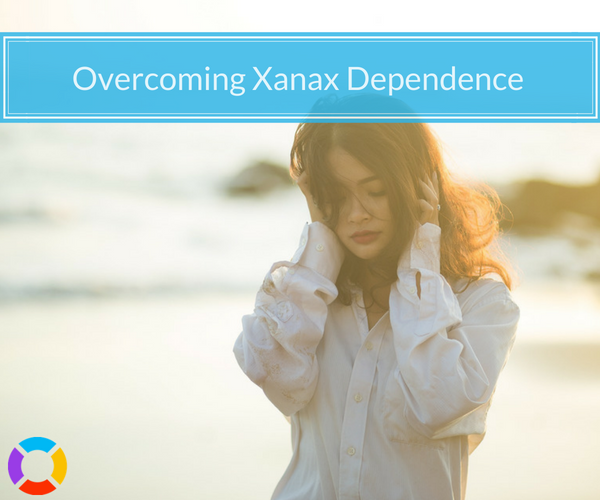Xanax Detox: Withdrawal Timeline, Symptoms, Tapering, and Treatment Options

For anyone who has found themselves struggling with a Xanax dependency, the idea of detox can be intimidating and might be enough to make you hesitate to seek recovery. But with the help of professionals, Xanax detox is possible in a healthy and manageable way that sets you up for a better life ahead.
Whether it’s you or a loved one who may need Xanax detox, the information below will help you to get an understanding of what’s ahead and how to make the detox experience as positive as possible.
What Is Xanax?
Xanax is the brand name for alprazolam, a short-acting benzodiazepine prescribed primarily for anxiety and panic disorders.
As a central nervous system (CNS) depressant, Xanax enhances the effect of a neurotransmitter called gamma aminobutyric acid (GABA), and this works to calm brain activity. Xanax is an FDA Schedule 4 medication, meaning it has both a recognized medical use and the potential for abuse and dependence.
Xanax vs. Alprazolam
While both medicines contain the same active ingredient, Xanax refers to the name brand of the medication. Alprazolam is the generic equivalent.
How Long Does Xanax Last?
The Xanax peak typically occurs within one to two hours, and the drug stays in the body for 12 to 15 hours. Metabolism and dosage may affect the amount of time Xanax is active in the body.
Have questions about detox? Call today, and get answers.
Is Xanax Addictive?
Yes, Xanax addiction is possible. According to the National Center for Drug Abuse Statistics, more than 4.8 million people abused benzodiazepines like Xanax in the past year.
Xanax’s fast acting nature creates a high potential for tolerance and physical dependence, even when taken as prescribed. Xanax dependence can develop in as little as a few weeks.
Short acting benzodiazepines like Xanax are linked to a faster onset of addiction than longer acting anti anxiety drugs like clonazepam. People who take Xanax may be more susceptible to addiction than people who take longer acting drugs due to both the drug’s rapid effects and withdrawal symptoms.
Signs and Symptoms of Xanax Addiction
Recognizing Xanax addiction signs early is vital. Symptoms of Xanax addiction can be physical, behavioral, or psychological.
Physical symptoms of Xanax addiction may include:
- Drowsiness or fatigue
- Slurred speech
- Dizziness
- Nausea
- Coordination problems
Behavioral symptoms of Xanax addiction can include:
- Secretive use or hiding pills
- Increased tolerance
- “Doctor shopping” (going to multiple doctors to find one that will prescribe Xanax) or buying medication illegally
- Withdrawal from responsibilities
- Increased tolerance
Finally, psychological symptoms of Xanax addiction may include:
- Cravings
- Anxiety about running out
- Obsession with finding the next dose
What is Xanax Detox?
Xanax detox refers to the process of safely removing Xanax from your body and allowing your body to adjust to functioning without Xanax.
If you have a Xanax addiction, detox is not a full treatment course, meaning that detox alone won’t resolve the addiction. Rather, it stabilizes your mind and body to begin inpatient or outpatient rehab.
Your detox care team will work with you to create a plan to help you detox as safely and comfortably as possible. Medical supervision is key, as withdrawal symptoms can be dangerous.
Your detox team will work with you to determine what medications, therapies, and holistic treatment methods can best support the start of your sobriety.
Symptoms of Xanax Withdrawal
Xanax withdrawal symptoms can be serious, and you must work closely with your medical treatment team to manage the side effects of the withdrawal process.
About 44% of people who take Xanax experience moderate to severe withdrawal symptoms when they stop taking the drug, even if they followed instructions on how to take Xanax properly.
Side effects can vary in severity and may depend on how long you’ve been taking Xanax, the dose you normally take, and whether you’ve been following your care provider’s dosage and timing instructions.
Mild symptoms of Xanax withdrawal can include:
- Insomnia
- Anxiety
- Irritability
- Sweating
- Muscle aches and pains
Moderate symptoms of Xanax withdrawal may include:
- Nausea
- Vomiting
- Panic attacks
- Sensitivity to light and sound
- Depression
Some people may have severe symptoms of Xanax withdrawal which may include:
- Hallucinations
- Seizures which may be life-threatening
- Delirium
- Hallucinations
Watch your symptoms. Call today to get help.
Xanax Withdrawal Timeline
If you’re considering going through Xanax detox, you likely have many questions, including “how long does Xanax withdrawal last?” or “what does Xanax withdrawal feel like?”.
While everyone’s experience varies, understanding an average Xanax detox timeline can help you know what to expect as you move through the withdrawal process.
| Time since last use | Symptoms |
| 0-12 hours | Anxiety, restlessness, panic attacks, tremors, sweating, headaches, nausea |
| 1-3 days | Anxiety and restlessness peak, highest seizure risk |
| 4-7 days | Physical symptoms begin to ease, insomnia continues |
| 7 days + | Potential post-acute withdrawal syndrome (PAWS), may include depression and anxiety |
Dangers of Quitting Xanax Cold Turkey
Stopping Xanax cold turkey is dangerous, and stopping your medication suddenly increases your risk of hospitalization or death. Xanax withdrawal seizures can be fatal.
Instead, tapering off Xanax slowly allows your mind and body time to adjust to functioning without Xanax, reducing the risk of severe or life threatening withdrawal symptoms. Your detox care team will work with you to develop a taper plan that makes sense for your needs.
How to Taper Off Xanax Safely
Tapering off Xanax means slowly reducing your dose over time. You must work closely with your doctor or other healthcare provider to ensure that you’re following a safe taper schedule.
Typically, it’s recommended that people tapering off of Xanax reduce their dosage by 10 to 25% every one to two weeks, but your doctor will create a specific plan for you based on your dosage, your pre-treatment symptoms, and other factors.
Weaning off of Xanax too quickly can result in seizures and rebound symptoms. Your doctor may recommend that you use a longer acting benzodiazepine such as diazepam to lead to a smoother withdrawal.
Xanax Detox Treatment Options
Xanax detox focuses on medically supported stabilization, safety, and preparation for longer term recovery. You can go through the detox process on an inpatient or outpatient basis. If you’re not sure about how to move forward with Xanax medical detox, your care provider can help.
When you enter your detox facility, you’ll receive a combination of medical treatment, emotional support, and therapy to help you begin your sobriety. Your care team will also work with you to help you determine your next steps, allowing you to continue your treatment after the detox process is complete.
Don’t wait to get treatment. Call now.
Inpatient vs Outpatient Xanax Detox
Choosing the right level of care is essential for successfully completing the detox process.
If you have a severe level of substance use disorder or if you do not have a stable living environment or excellent support at home, it may make the most sense for you to attend an inpatient detox program. People with mild addiction and a high level of support at home may benefit from an outpatient detox program.
| Inpatient detox | Outpatient detox | |
| Setting | 24 hour, live in care | Home based care |
| Monitoring | Constant | Scheduled check ins |
| Cost | Higher | Lower |
| Best for | Severe addiction and people with medical or mental health conditions | Milder addiction |
| Benefits | Medical supervision | Flexibility |
Medications for Xanax Withdrawal
Many people who are considering Xanax detox are curious about what helps with Xanax withdrawal. Fortunately, many behavioral and pharmaceutical options can support the start of your recovery.
Commonly used Xanax withdrawal medications include:
- Diazepam (Valium) or clonazepam (Klonopin): Both of these medications are slower acting benzodiazepines which can help you move through the Xanax taper process while reducing withdrawal symptoms.
- Hydroxyzine: This medication is non addictive and can help to ease anxiety and tension.
- Gabapentin: This medication can control seizures and help you get the sleep you need during detox.
- Other anticonvulsants: These medications can help to prevent seizures.
How Long Does Xanax Detox Take?
The time it will take for you to go through Xanax detox depends on several factors. If you’ve been taking a higher dose of medication, or you’ve been taking Xanax for a long time, you’ll likely have a longer detox period than someone taking a smaller dose or someone who has not used it for a long time.
Your age and health can also play a role in determining the length of time it will take you to move through the detox process.
Some people experience post acute withdrawal syndrome or PAWS. This can begin after about a week of acute withdrawal and can last for several months. Symptoms of PAWS may include concentration problems, depression, anxiety and irritability as well as insomnia, memory problems and mood swings.
While your acute detox symptoms will fade within a week or so, you’ll need ongoing treatment to help you maintain your sobriety. Inpatient or outpatient treatment will typically last 30, 60, or 90 days after detox, allowing you to develop the skills, emotional healing and shifted thought patterns you’ll need to stay sober long term.
Don’t detox alone! Call now, get the help you need.
What Happens After Detox?
As you near the end of detox, your care team will work with you to develop a plan to support your ongoing Xanax recovery. Together, you’ll decide whether inpatient or outpatient treatment for Xanax addiction makes the most sense for your needs.
If you’re living with an additional mental health condition, you’ll need a dual diagnosis treatment center that can provide care for substance use disorder and other mental health issues at the same time.
During your inpatient or outpatient treatment program for Xanax addiction, your care team will work with you to create an individualized treatment plan to support your sobriety.
Most treatment plans include a variety of therapies, which may include cognitive behavioral therapy (CBT), dialectical behavior therapy (DBT), 12 step programming like Narcotics Anonymous or SMART Recovery, and more. You may receive trauma therapy, depending on your history and your needs.
You’ll also discuss lifestyle changes, stress management, and coping strategies that you can use to maintain your sobriety after treatment ends.
FAQs About Xanax Detox
Yes, Xanax withdrawal can cause seizures. It’s important to go through detox with a medical care team to reduce your risk and to have support if seizures do occur.
Typically, acute Xanax withdrawal lasts for about a week. Some people may experience post acute withdrawal symptoms that can last for a few months after acute withdrawal symptoms subside.
Working with a qualified medical detox team is the safest way to detox from Xanax as you prepare for inpatient or outpatient addiction treatment.
Xanax withdrawal typically begins within 12 to 24 hours after your last pill.
It’s not safe to detox from Xanax at home on your own, as withdrawal symptoms can be life-threatening. You’ll need to go through inpatient or outpatient detox with supervision from medical professionals.
Most doctors recommend reducing your Xanax dosage by 10% to 25% every one to two weeks to minimize withdrawal symptoms.
Find a Xanax Detox Center Today to Begin a Life After Addiction
If you’re ready to start detox for Xanax addiction and want a more guided option than searching “Xanax detox centers near me,” we’re here to help. Explore detox centers in your area on our Detox.com directory to find facilities that meet your needs.



